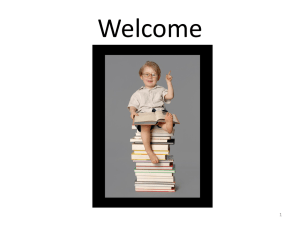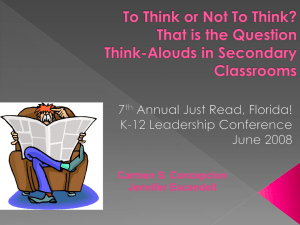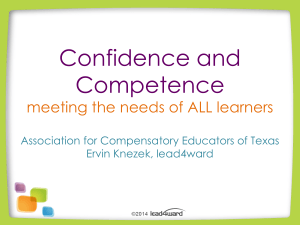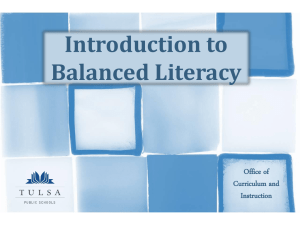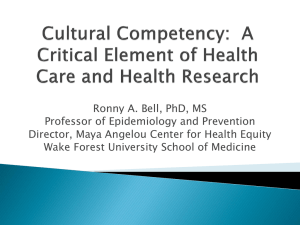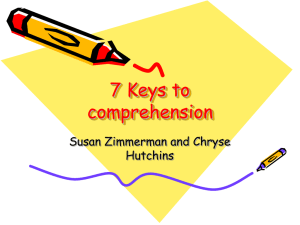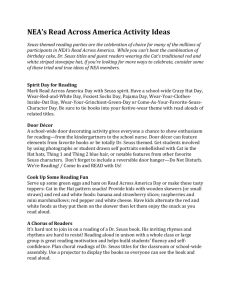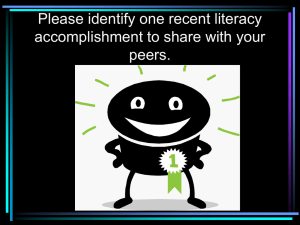Handout - Reading Horizons
advertisement
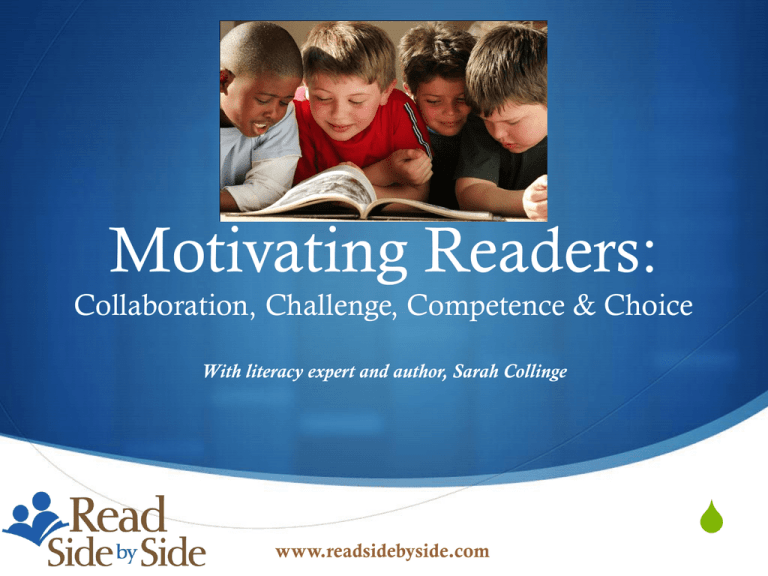
Motivating Readers: Collaboration, Challenge, Competence & Choice With literacy expert and author, Sarah Collinge www.readsidebyside.com S What motivates a love of reading? What motivates a love of reading? S Collaboration S Challenge S Competence S Choice Collaboration 1. Read Aloud To Your Child Collaboration 2. Talk About the Book Together Children benefit from structured conversations with an adult in response to written texts (CCSS, Appendix A, p. 27). Mem Fox http://www.readingrockets.org/podcasts /reading_aloud/ “If we are reading aloud always something that is more difficult than children can read themselves then when they come to that book later, or books like that, they will be able to read them—which is why even a fifth grade teacher, even a tenth grade teacher, should still be reading to children aloud. There is always something that is too intractable for kids to read on their own.” S Listening Comprehension Sets the Upper Limits! 0 6 13 Children’s literacy comprehension outpaces reading comprehension until the middle school years (CCS, Appendix A, p. 27). If literacy levels are to improve, oral language must be used purposefully and systematically in the language arts classroom. The Common Core Standards put an emphasis on students’ ability to debate, as this ability is critical to college and career readiness. When the book said ______ I was thinking _______ because _______. I agree with you because _______. OR I disagree with you because ____. Challenge 3. Select rich, challenging literature to read aloud together. What students read, in terms of complexity, is at least as important as what they can do with what they read (CCS, Appendix A, p. 2). Complex Text • • • • • • • • Multiple themes Implied purpose Unconventional structure Figurative language Unfamiliar language or dialect Domain specific vocabulary Background knowledge needed Intertextual demands Third Grade Read Aloud Exemplars (CCS): Literature: • Chapter books • Classic Literature • Award Winners • Books that require background knowledge S Competence Motivation to read is closely tied to our beliefs about ourselves. Children are more likely to want to read when: S They believe they are a good reader S They believe other people see them as a good reader S They feel part of the reading community Competence “It is the match between the student and the topic or genre that determines the likelihood of comprehension.” (Snow, 2002) Competence Build background knowledge about a topic prior to reading. Competence Build background knowledge about a genre prior to reading. Realistic Fiction Setting Realistic/believable place Present time Characters Fictional Characters that are very real and believable The main character changes over time Plot The character must deal with a real-life problem Most important Element Character Readers will think about How the main character changes over time How the main character overcomes challenges The main character’s beliefs about right and wrong How the main character’s circumstances impact his/her choices Competence 4. After reading a book aloud to your student, select a slightly easier book about the same topic or of the same genre for your child to read independently. Early Readers Charlotte’s Web E. B. White Mercy Watson Series Kate DiCamillo Fluent Readers Earthquake Terror Peg Kehret Dog Heroes Mary Pope Osborne Proficient Readers Children of the Dust Bowl Jerry Stanley Out of the Dust Karen Hesse Competence Tip: Focus less on the level and more on the match between topic and/or genre. Myth: Instructional Level Theory-students learn best when they are matched to a specific text level. Truth: There is a lack of clear research evidence showing the benefits of matching kids to specific text levels. Shanahanonliteracy.com Competence 5. Continue to provide support as your student reads independently. Reading Conference Research Decide Teach Focus on helping students monitor their comprehension of the text: • • • • Character Setting Problem Main Events Earthquake Terror – Blurb Use the blurb as a guide From the beginning Jonathan is spooked by the deserted island where his family is camping—and his premonitions come true. After Jonathan’s mother breaks her ankle, Jonathan and his younger sister Abby are left alone. Then a devastating earthquake hits. The bridge is destroyed, the trailer is smashed, and there’s no food or water. Suddenly, Jonathan and Abby are fighting for their lives… Choice Providing choices increases both effort and achievement in reading. Choice 6. Expose your student to a variety of literature, always considering their interests. Allow them to make their own choices when appropriate. Emma Walton Hamilton http://www.readingrockets.org/podcasts/childrensbooks/ “Kids really need support and guidance in finding out what books work for them and what authors inspire them and what styles and genres they respond to. There are a number of ways we can help lead kids to books they love. I think the task is that we have to remember that they need us to do that, and we can’t expect them to just know what they love right off the bat. My advice to parents in helping your child select material to read is first and foremost know your child and help feed his/her individual passion.” S Choice Connect reading experiences to their curiosities about the world around them. Experiences I vividly remember a trip my family took to Victoria, BC during my fourth-grade year. We participated in all the tourist activities, including taking a trip to the Royal BC Museum. I remember the Modern History Gallery, especially the display of the coastal first nations. Shortly after that visit, I picked up my first Scott O’Dell novel, Island of the Blue Dolphins. Current Events My third grade teacher built our excitement for the launch of the Challenger by reading Weekly Reader with us. I will never forget the day of the Challenger explosion. This event became part of my personal history. Reading has the power to shape our personal history. History A real interest in a timeperiod is born when readers sense they are part of the story. Readers take on the circumstances and feelings of the characters as they read historical fiction. Help kids connect with their own family history— • Immigration • Service • Important Events People & Cultures Teaching kids about world cultures helps them appreciate differences in people and their traditions. Students build positive identities and respect for differences. “It only takes one really successful, thrilling, joyful, wonderful, losing oneself in the magic, reading experience to captivate a child’s imagination.” ~Emma Walton Hamilton Increase your child’s success with chapter books~ Raising the Standards Through Chapter Books: The C. I. A. Approach info@readsidebyside.com Readsidebyside.com

